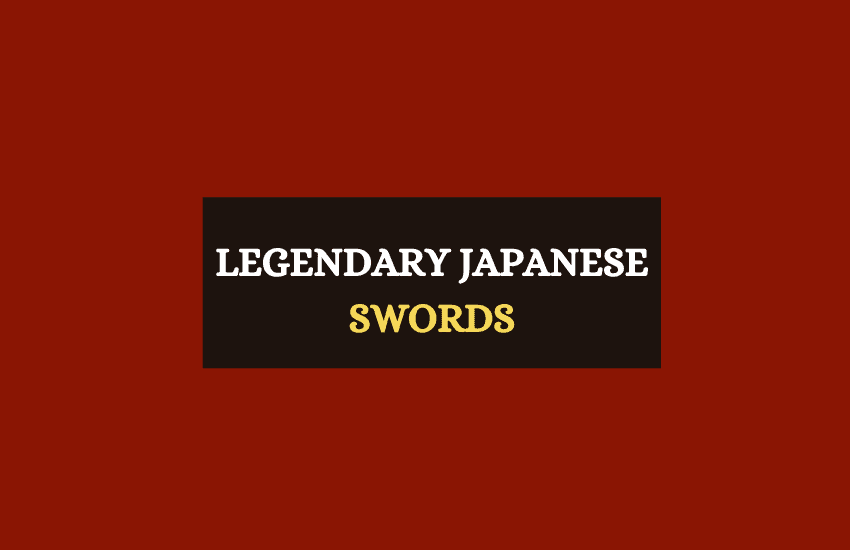
Table of Contents
Japanese history and mythology are full of amazing weapons. Spears and bows were favored by many mysterious Shinto and Buddhist deities as well as many samurai and generals.
The most famous type of weapon in Japan, however, is undoubtedly the sword.
From the legendary centuries-old swords that are kept in museums to this day to the mythological Ten Hand-Breadths swords wielded by the Shinto kami gods, one can easily get lost in the world of the fantastic legendary and mythological Japanese swords.
The Different Totsuka no Tsurugi Swords in Japanese Mythology
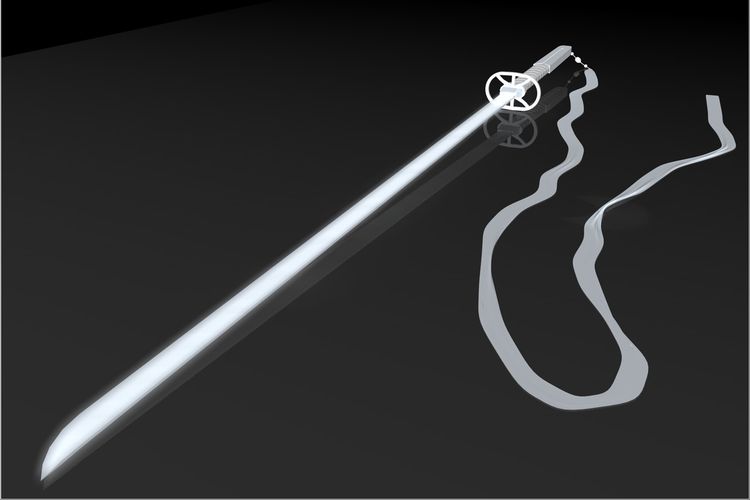
For clarity’s sake, we’ll discuss mythological and historical Japanese swords in two different sections even though the two groups often overlap. And to kick things off, we’ll start with a special group of Japanese mythological swords – the Totsuka no Tsurugi swords.
The term Totsuka no Tsurugi (十拳剣) literally translates as Sword of Ten Hand-Breadths (or ten palm lengths, referring to these swords’ impressive length).
When reading Shinto myths for the first time it’s easy to confuse that as a name of an actual sword. That’s not the case, however.
Instead, Totsuka no Tsurugi is a special class of magical swords used by multiple Shinto kami gods throughout Shinto mythology.
Each of those Totsuka no Tsurugi swords usually has its own separate name such as Ame no Ohabari, the sword of the Father kami of Shintoism Izanagi, or Ame no Habakiri, the sword of the storm kami Susanoo.
Both of these swords are Totsuka no Tsurugi and their names are used interchangeably with this joint term in their respective myths.
But, to go into a bit more detail, let’s go over the 4 most famous Totsuka no Tsurugi swords one by one.
1- Ame no Ohabari (天之尾羽張)
Ame no Ohabari is the Totsuka no Tsurugi sword of the Shinto Father kami Izanagi. The most famous use of Ame no Ohabari was when Izanagi killed his own newborn son Kagutsuchi. The horrific accident occurred right after Kagutsuchi – a kami of fire – killed his own mother and Izanagi’s spouse, the Mother kami Izanami.
Kagutsuchi did this unintentionally as he just burned her during childbirth – the fire kami couldn’t control the fact that he was fully engulfed in flames. Nevertheless, Izanagi fell into a blind rage and cut his fiery son into several different pieces with Ame no Ohabari.
Izanagi then scattered Kagutsuchi’s remains across Japan, creating the eight big active volcanoes in the island nation. In short, this myth exemplifies Japan’s millennia-old struggle with the country’s many deadly volcanoes.
The myth doesn’t end there, however. After Kagutsuchi’s death and dismemberment, the Ame no Ohabari sword “gave birth” to several new Shinto gods from the blood of Kagutsuchi that was still dripping from the blade.
Some of these kami included Takemikazuchi, a kami of swords and thunder, and Futsunushi, another famous sword-wielding warrior kami.
2- Ame no Murakumo(天叢雲剣)
Also known as Kusanagi no Tsurugi (草薙の剣), the name of this Totsuka no Tsurugi sword translates as Cloud-gathering sword. The name is quite appropriate given that this was one of the two Ten Hand-Breadths swords used by the kami of storms Susanoo.
The storm kami stumbled upon Ame no Murakumo after he killed the Great Serpent Orochi. Susanoo found the blade within the monster’s carcass as a part of its tail.
As Susanoo had just had a major quarrel with his sister Amaterasu, the beloved Shinto kami of the sun, Susanoo took Ame no Murakumo back into Amaterasu’s heavenly realm and gave her the sword in an attempt for reconciliation. Amaterasu accepted and the two kami forgave each other for their quarrel.
Later on, the Ame no Murakumo sword was said to have been passed down to Yamato Takeru (日本武尊), the legendary twelfth Emperor of Japan.
Today, the sword is revered as one of the most sacred Japanese relics or as one of the Three Imperial Regalia of Japan together with the mirror Yata no Kagami and the jewel Yasakani no Magatama.
3- Ame no Habakiri (天羽々斬)
This Totsuka no Tsurugi sword is the second famous sword of the storm kami Susanoo. Its name translates as Snake-slayer of Takamagahara as this was the sword Susanoo used to slay the Orochi serpent.
While the storm god gave Ame no Murakumo to Amaterasu, he kept Ame no Habakiri for himself and continued using it throughout Shinto mythology.
Today, the sword is said to be enshrined in the famous Shinto Isonokami Shrine.
4- Futsunomitama no Tsurugi (布都御魂)
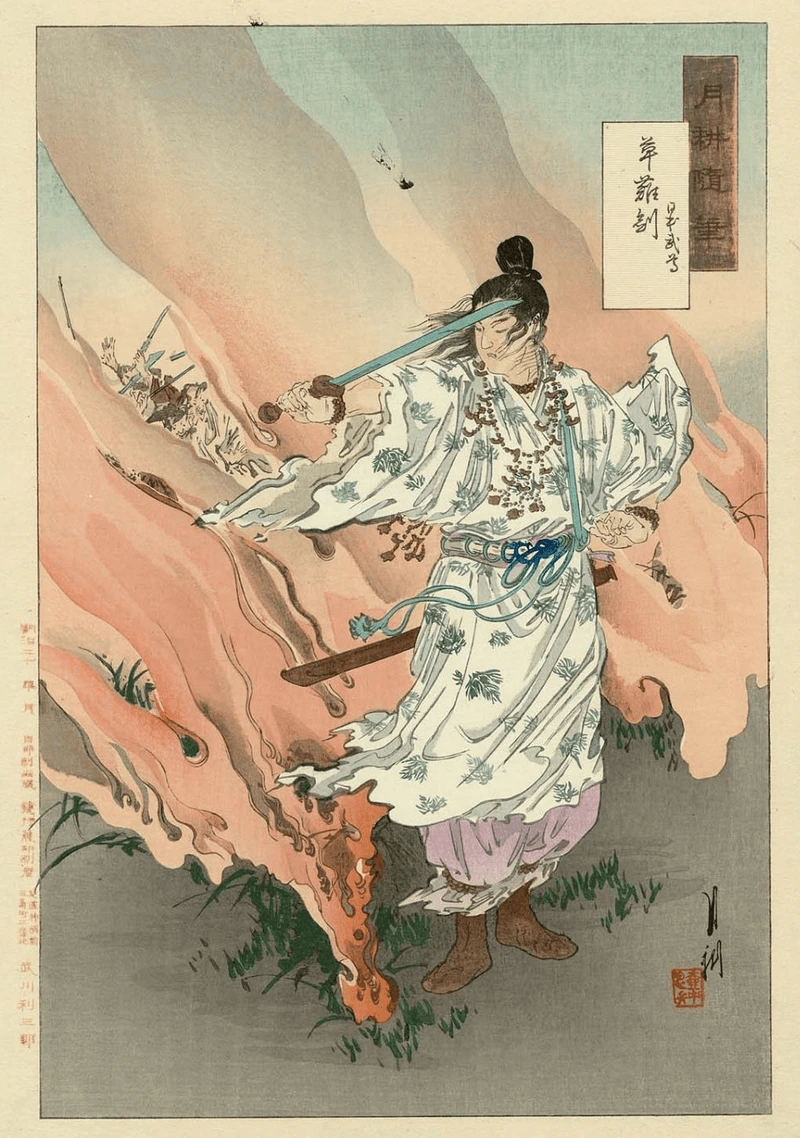
Another Totsuka no Tsurugi sword, Futsunomitama was wielded by Takemikazuchi – the kami of swords and storms born from Izanagi’s Totsuka no Tsurugi sword Ame no Ohabari.
Takemikazuchi is one of the most famous Shinto gods as he was the heavenly kami sent to Japan to “quell” the Middle Country, i.e. the old Izumo Province in Japan.
Takemikazuchi fought lots of monsters and minor Earth kami in his campaign and eventually managed to subjugate the province with his mighty Futsunomitama sword.
Later, in another myth, Takemikazuchi gave the Futsunomitama sword to the legendary Japanese Emperor Jimmu to help him conquer the Kumano region of Japan. Today, the spirit of Futsunomitama is also said to be enshrined in the Isonokami Shrine.
The Tenka Goken or the Five Legendary Blades of Japan

In addition to the many powerful mythological weapons in Shintoism, Japan’s history is also full of many famous samurai swords. Five of them are especially legendary and are known as Tenka Goken or the Five Greatest Swords Under Heaven.
Three of these weapons are viewed as National Treasures of Japan, one is a holy relic of Nichiren Buddhism, and one is an Imperial Property.
1- Dōjikiri Yasutsuna (童子切)
Dōjikiri or the Slayer of Shuten-dōji is arguably the most famous and revered of the Tenka Goken blades. He is often regarded as “The yokozuna of all Japanese swords” or the highest-ranked of all swords in Japan for its perfection.
The iconic sword was crafted by the famous bladesmith Hōki-no-Kuni Yasutsuna somewhere between the 10th and 12th century AD. Viewed as a National Treasure, it’s currently housed in the Tokyo National Museum.
The most famous feat of the Dōjikiri Yasutsuna sword is the slaying of Shuten-dōji – a powerful and evil ogre that plagued the Izu Province. At the time, Dōjikiri was wielded by Minamoto no Yorimitsu, one of the earliest members of the famous Minamoto samurai clan.
And while the slaying of an ogre is likely just a myth, Minamoto no Yorimitsu is a known historic figure with many documented military exploits.
2- Onimaru Kunitsuna (鬼丸国綱)
Onimaru or just Demon is a famous sword crafted by Awataguchi Sakon-no-Shōgen Kunitsuna. It’s one of the legendary swords of the shoguns of the Ashikaga clan that ruled Japan between the 14th and 16th centuries AD.
One story in the Taiheiki historical epic claims that Onimaru was able to move on its own and once even killed an oni demon that was tormenting Hōjō Tokimasa of the Kamakura Shogunate.
The oni demon was plaguing Tokimasa’s dreams every night until an old man came to Tokimasa’s dreams and presented himself as the spirit of the sword.
The old man told Tokimasa to clean the sword so that it could take care of the demon. Once Tokimasa cleaned and polished the sword, Onimari jumped up and killed the demon.
3- Mikazuki Munechika (三日月)
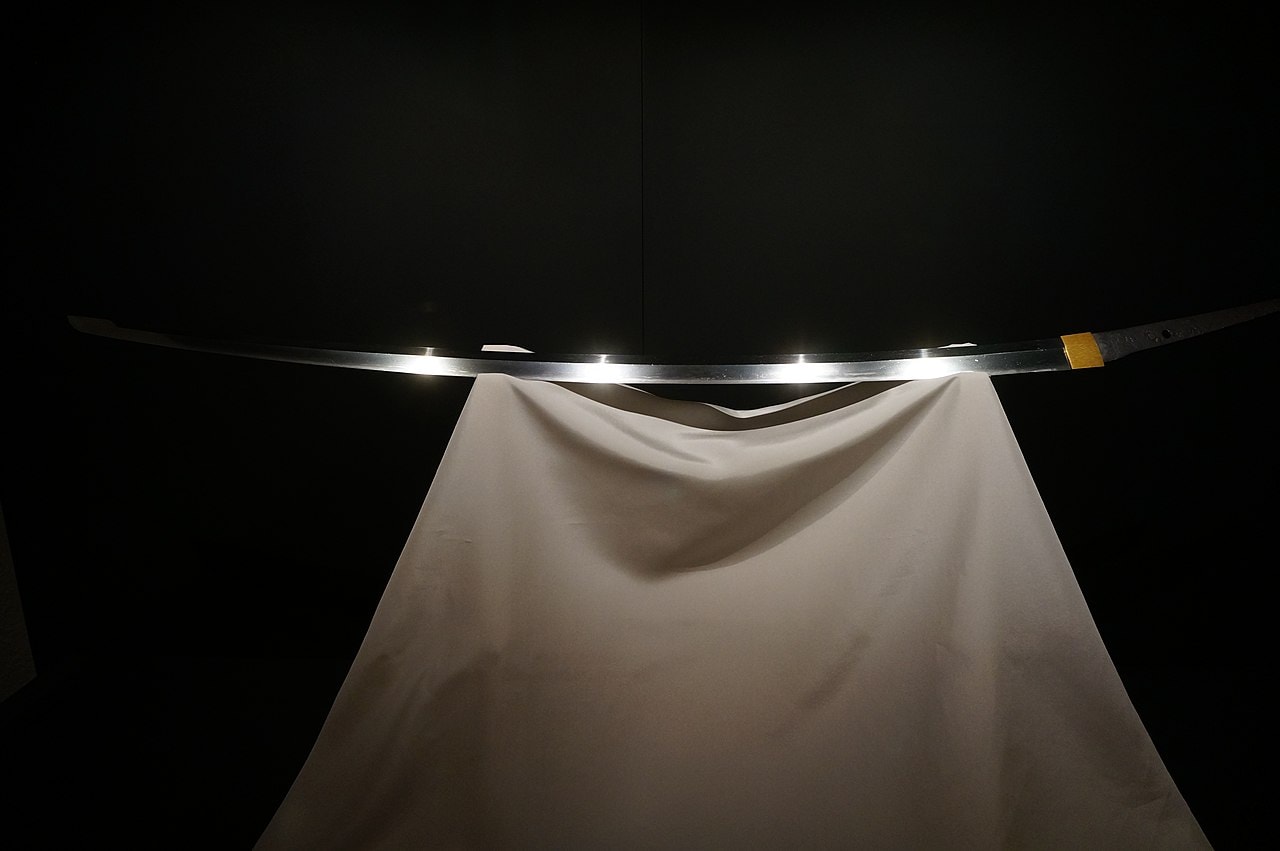
Translating as Crescent Moon, Mikazuki was crafted by the bladesmith Sanjō Kokaji Munechika between the 10th and 12th centuries AD. It’s called Mikazuki because of its pronounced curved shape even though a curvature of ~2.7 cm is not that unusual for a katana sword.
The Japanese Noh play Kokaji tells that the Mikazuki sword was blessed by Inari, the Shinto kami of foxes, fertility, and prosperity. Also viewed as a National Treasure, Mikazuki is currently owned by the Tokyo National Museum.
4- Ōdenta Mitsuyo (大典太)
The Ōdenta sword was crafted by the bladesmith Miike Denta Mitsuyo. Its name literally translates as Great Denta or The Best among Swords Forged by Denta. Together with Onimaru and Futatsu-mei, Ōdenta is considered to be one of the three regalia swords owned by the shoguns of the Ashikaga clan.
It’s also believed that the sword was once owned by Maeda Toshiie, one of the most legendary Japanese generals. There’s even a legend of Ōdenta once healing one of the daughters of Toshiie.
5- Juzumaru Tsunetsugu (数珠丸)
Josumaru or Rosary was created by Aoe Tsunetsugi. It’s currently owned by the Honkōji Temple, Amagasaki, and is viewed as an important Buddhist relic. The sword is believed to have belonged to Nichiren, a famous Japanese Buddhist priest of the Kamakura period (12th to 14th century AD).
According to the legend, Nichiren adorned the sword with juzu, a type of Buddhist rosary which is where the name Juzumaru comes from. The purpose of the juzu was to cleanse evil spirits and so Juzumaru is believed to have magical cleansing properties.
Other Legendary Japanese Swords
There are nearly countless other legendary swords in Shintoism, Buddhism, and in Japanese history and it’d be impossible to cover all of them. Some are definitely worth mentioning, however, so let’s go over several others of the most legendary Japanese swords below.
1- Muramasa (村正)
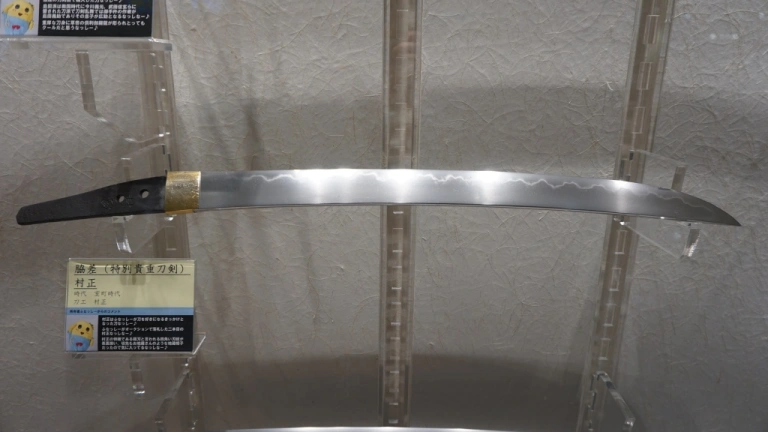
In modern pop culture, Muramasa swords are often viewed as cursed blades. Historically, however, these swords take their name from the family name of Muramasa Sengo, one of the finest Japanese bladesmiths who lived in the Muromachi Era (14th to 16th century AD while the Ashikaga clan ruled Japan).
Muramasa Sengo created many legendary blades in his time and his name lived on through the centuries. Eventually, a Muramasa school was founded by the powerful Tokugawa clan to teach future bladesmiths to craft swords as good as those of Muramasa Sengo.
Because of a series of unfortunate events, however, later Tokugawa leaders came to view Muramasa swords as sinister and cursed weapons that shouldn’t be used.
Today, a number of Muramasa swords are still well-preserved and are occasionally shown in exhibitions and museums across Japan.
2- Kogitsunemaru (小狐丸)
Kogitsunemaru, or Small Fox as it translates in English, is a mythical Japanese sword believed to have been crafted by Sanjou Munechika in the Heian Period (8th to 12th century AD).
The sword is believed to have last been owned by the Kujou Family, but it’s now believed to be lost.
What’s unique about Kogitsunemaru is the story of its creation. Sanjou is said to have had a little help in the creation of this legendary sword by a child avatar of Inari, the Shinto kami of foxes, among other things, hence the name Small Fox.
Inari was also the patron god of Emperor Go-Ichijō who ruled in the Heian Period around the creation of the Small Fox sword.
3- Kogarasumaru (小烏丸)
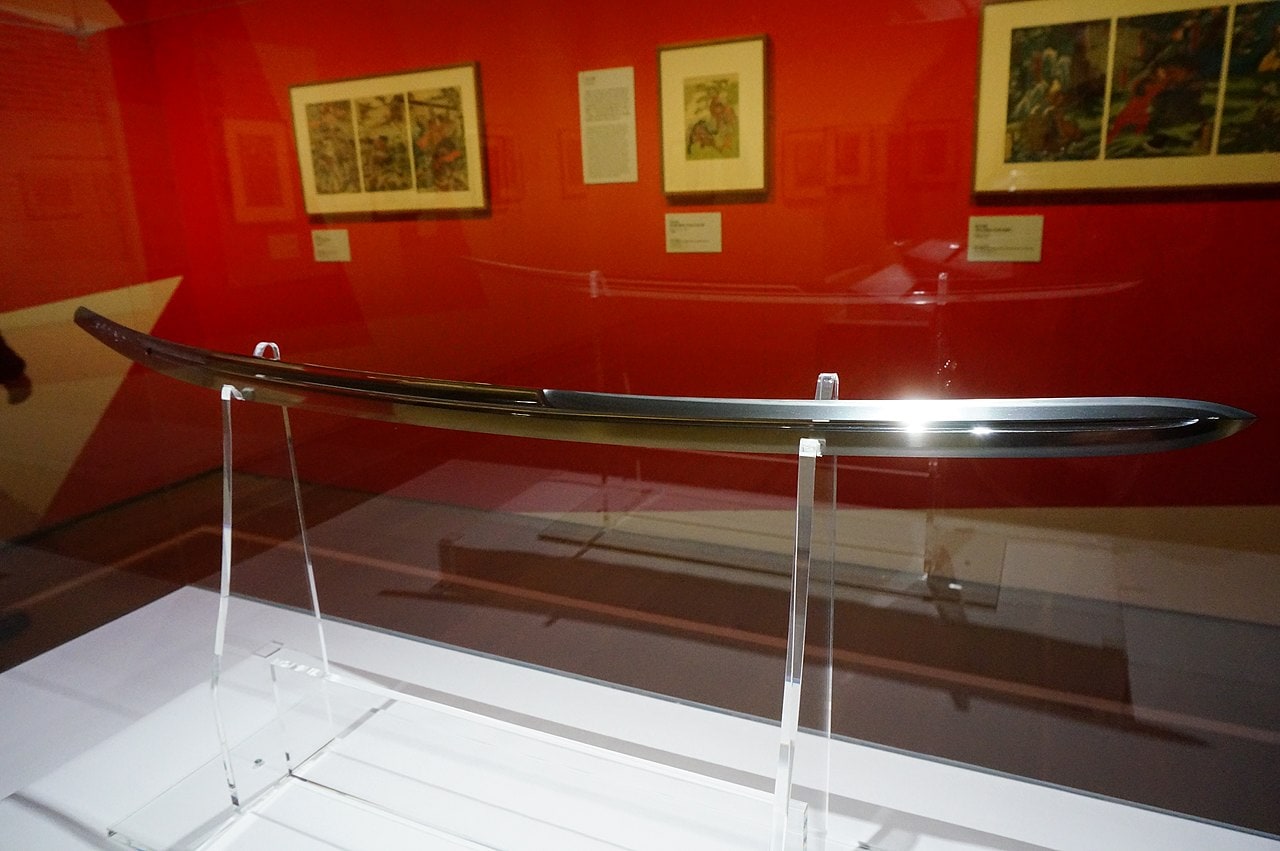
One of the most famous Japanese Tachi samurai swords, Kogarasumaru was likely crafted by the legendary bladesmith Amakuni in the 8th century AD. The sword is a part of the Imperial Collection today as the blade continues to be well-preserved.
The sword is believed to be one of the very first samurai swords ever created. It was also an heirloom of the famous Taira Family during the Genpei Civil War of the 12th century between the Taira and Minamoto clans.
There are also several mythical legends about the sword. One of them claims that it was given to the Taira Family by Yatagarasu, the divine three-legged crow of the sun in Shinto mythology.
Wrapping Up
This list goes to show the extent to which swords appear in Japanese mythology and history, and yet is, by no means, an exhaustive list.
Each of these swords carry their own legends and myths, and some are still preserved carefully.








